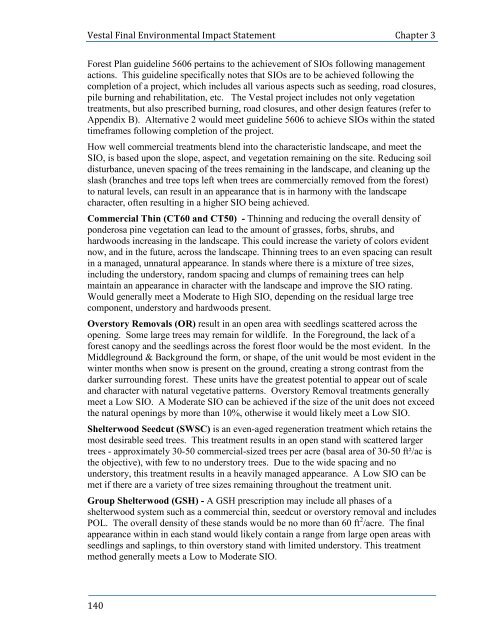Final Environmental Impact Statement
Final Environmental Impact Statement
Final Environmental Impact Statement
Create successful ePaper yourself
Turn your PDF publications into a flip-book with our unique Google optimized e-Paper software.
Vestal <strong>Final</strong> <strong>Environmental</strong> <strong>Impact</strong> <strong>Statement</strong> Chapter 3<br />
Forest Plan guideline 5606 pertains to the achievement of SIOs following management<br />
actions. This guideline specifically notes that SIOs are to be achieved following the<br />
completion of a project, which includes all various aspects such as seeding, road closures,<br />
pile burning and rehabilitation, etc. The Vestal project includes not only vegetation<br />
treatments, but also prescribed burning, road closures, and other design features (refer to<br />
Appendix B). Alternative 2 would meet guideline 5606 to achieve SIOs within the stated<br />
timeframes following completion of the project.<br />
How well commercial treatments blend into the characteristic landscape, and meet the<br />
SIO, is based upon the slope, aspect, and vegetation remaining on the site. Reducing soil<br />
disturbance, uneven spacing of the trees remaining in the landscape, and cleaning up the<br />
slash (branches and tree tops left when trees are commercially removed from the forest)<br />
to natural levels, can result in an appearance that is in harmony with the landscape<br />
character, often resulting in a higher SIO being achieved.<br />
Commercial Thin (CT60 and CT50) - Thinning and reducing the overall density of<br />
ponderosa pine vegetation can lead to the amount of grasses, forbs, shrubs, and<br />
hardwoods increasing in the landscape. This could increase the variety of colors evident<br />
now, and in the future, across the landscape. Thinning trees to an even spacing can result<br />
in a managed, unnatural appearance. In stands where there is a mixture of tree sizes,<br />
including the understory, random spacing and clumps of remaining trees can help<br />
maintain an appearance in character with the landscape and improve the SIO rating.<br />
Would generally meet a Moderate to High SIO, depending on the residual large tree<br />
component, understory and hardwoods present.<br />
Overstory Removals (OR) result in an open area with seedlings scattered across the<br />
opening. Some large trees may remain for wildlife. In the Foreground, the lack of a<br />
forest canopy and the seedlings across the forest floor would be the most evident. In the<br />
Middleground & Background the form, or shape, of the unit would be most evident in the<br />
winter months when snow is present on the ground, creating a strong contrast from the<br />
darker surrounding forest. These units have the greatest potential to appear out of scale<br />
and character with natural vegetative patterns. Overstory Removal treatments generally<br />
meet a Low SIO. A Moderate SIO can be achieved if the size of the unit does not exceed<br />
the natural openings by more than 10%, otherwise it would likely meet a Low SIO.<br />
Shelterwood Seedcut (SWSC) is an even-aged regeneration treatment which retains the<br />
most desirable seed trees. This treatment results in an open stand with scattered larger<br />
trees - approximately 30-50 commercial-sized trees per acre (basal area of 30-50 ft²/ac is<br />
the objective), with few to no understory trees. Due to the wide spacing and no<br />
understory, this treatment results in a heavily managed appearance. A Low SIO can be<br />
met if there are a variety of tree sizes remaining throughout the treatment unit.<br />
Group Shelterwood (GSH) - A GSH prescription may include all phases of a<br />
shelterwood system such as a commercial thin, seedcut or overstory removal and includes<br />
POL. The overall density of these stands would be no more than 60 ft 2 /acre. The final<br />
appearance within in each stand would likely contain a range from large open areas with<br />
seedlings and saplings, to thin overstory stand with limited understory. This treatment<br />
method generally meets a Low to Moderate SIO.<br />
140

















